How to Ferment Cabbage and Make Raw Sauerkraut
If you think that eating more fresh, natural raw food in your diet is too expensive, then this recipe is definitely for you! Making fermented foods at home is one of the most inexpensive ways to enjoy raw food. For optimal digestive health, we need to get good bacteria in gut on a regular basis. Antibiotics destroy all the bacteria in our system, both good and bad. Over time, this can lead to more imbalance in digestion function, absorption and elimination. Some experts even say that food allergies, autism and ADHD may be related to an imbalance of bacteria in the colon. Certainly many digestive diseases like colitis, diverticulitis and Crohn’s disease are caused in part by lack of good bacteria in the gut. Having the right balance of good bacteria helps to strengthen immune system, improve digestive health and long-term, can even prevent dis-ease. Probiotic, or good bacteria, literally means “for life.”
All information in this article is for educational purposes only.
It is not for the diagnosis, treatment, prescription or cure of any disease or health condition.
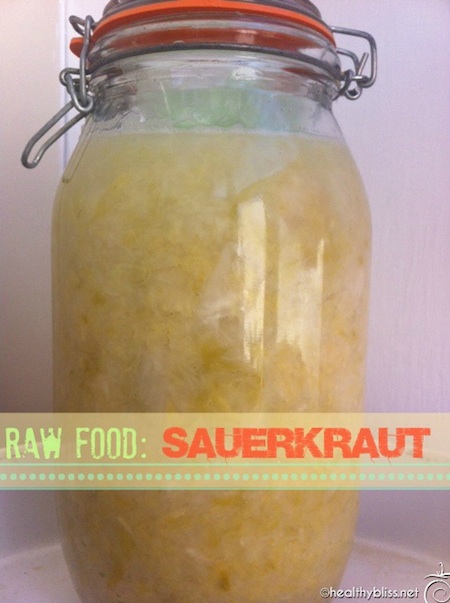
How to Make Raw Sauerkraut at home, a healthy naturally fermented food
How can we get good bacteria or “probiotics” back in the gut? The Western diet has virtually eliminated all traditionally fermented foods out of the diet, with the exception of yogurt. Store-bought yogurt is pasteurized, and usually contains added sugar, flavor and colorings. It’s also not a suitable option for vegans, and it’s expensive! Nowadays you will see Kombucha drink as a fermented raw food vegan option. Kombucha is fantastic, but it is also expensive at $6.00 per bottle. You may see sauerkraut for sale in supermarkets, but it’s already been pasteurized, so virtually all of the good bacteria has already been destroyed.
Not to worry! If you have just a few heads of cabbage, some salt and a few jars, you can easily make your own raw sauerkraut at home! It’s so easy to make that you will be wondering why you didn’t make it sooner! Cabbage is not expensive, and once the sauerkraut is made, you only need to add about 2 Tbsp. per day to your salad or veggies to get the good bacteria that your body needs. At that rate, 2 heads of cabbage could easily last up to 2 weeks for a family of 4. That’s some healthy savings!

What You Need: Raw cabbage, salt, a grater and jars
How to Make Homemade Raw Sauerkraut
Raw Sauerkraut: Ingredients
- 2 medium-large organic green cabbage heads (or purple cabbage)
- 1-1.5 Tablespoons Himalayan Salt or Pure Sea Salt
- 1 Tablespoon caraway and/or mustard seeds (optional)
- 2-3 sprigs fresh dill (optional)
- 2 organic carrots (optional)
Raw Sauerkraut: Equipment
- Grater or Mandolin
- Cutting Board and Knife
- Large Mixing bowl
- Wooden Mallet (optional)
- Large widemouth canning jar (or extra large mason jars)
- Small glass baby-food jar or small glass cup to fit inside the larger jar
- Clean rock or other weights to fit inside the small jar (to weigh down the cabbage)
- Old t-shirt or towel for covering the jar
- Large plate to catch any overspill
Instructions
Clean all materials before starting. Fermentation can be a sensitive process, and if there is any soap residue in your jars or hand cream chemicals on your hands, the fermenting might not work. I prefer to wash everything with a 50/50 mix of tap water and boiled water. For safety reasons, I do not recommend using 100% boiled water. Be careful not to rinse your jars with only boiling water because the glass can crack. Add tap water first, then some boiled water. Swish everything around and rinse. Wash your hands well with clean water and no soap.
Shred the Cabbage. Peel off the leaves of the cabbage and set them aside for later. Grate the cabbage on the large grate side of the grater or use a mandolin to shred the cabbage. Be sure to use the safety mechanism on the mandolin!
Combine Cabbage and Salt. Place the shredded cabbage to a large bowl and sprinkle some of the salt over top. If you have a wooden mallet, then start pounding the cabbage. If using only hands, then begin massaging and squeezing the cabbage with your hands. In just a few minutes, you should start to see the cabbage becoming watery and limp – this is a good sign! You can add some shredded carrot at this stage too (optional).
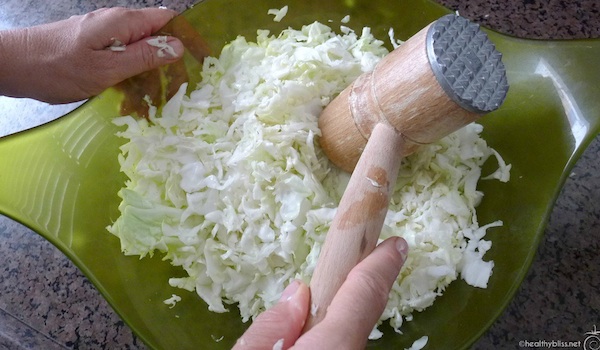
Making Raw Sauerkraut: Use a wooden mallet and pound away!

Add the salt. Then start squeezing by hand…
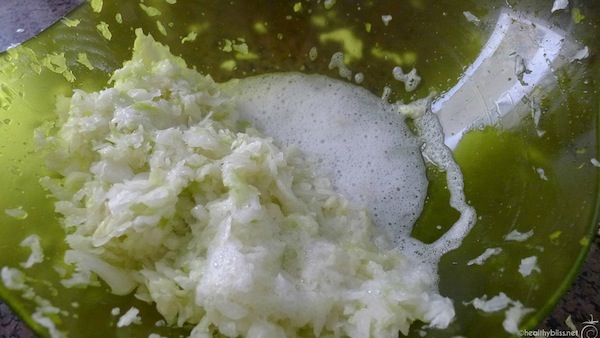
As you squeeze the cabbage, it will start to soften and you should see liquid/water. Put the liquid and cabbage in a glass jar for fermenting, pushing out any air bubbles. You can also add fresh dill, whole mustard seeds or caraway seeds for flavor.
Pack Cabbage and Liquid into Jar. Use your hands to pack the cabbage into the jar, pressing out any air bubbles each time you add more. At this stage, you can add some fresh dill, caraway seeds or mustard seeds for flavor. Pour any excess liquid from the cabbage into the jar. When the jar is nearly full, place a few of the larger outer leaves to cover the surface of the sauerkraut. This helps keep the cabbage submerged.
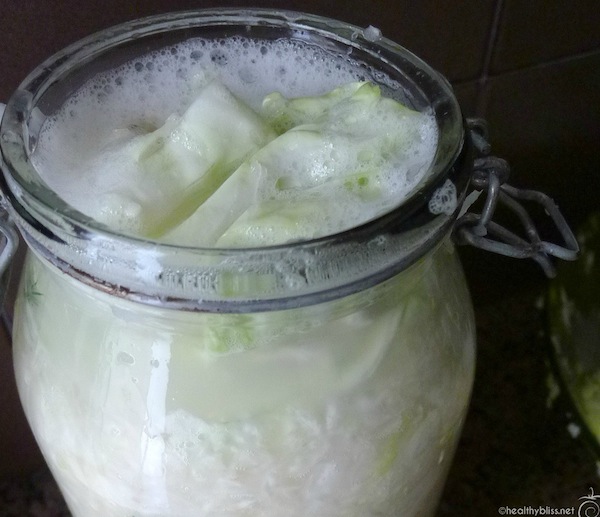
Gently press out air bubbles. Place some large cabbage leaves on top and be sure that your cabbage is all covered by the liquid. If necessary, add a small amount of water to cover the cabbage.
Cover the Jar. Place your filled jar on a dish, cover it with an old t-shirt or towel and put it in a quiet place to happily start fermenting. Ideally, your jar will be on top on a cabinet or on a table where it will not be disturbed. The best place is away from direct sunlight and at a cool room temperature — ideally 65°F to 75°F.
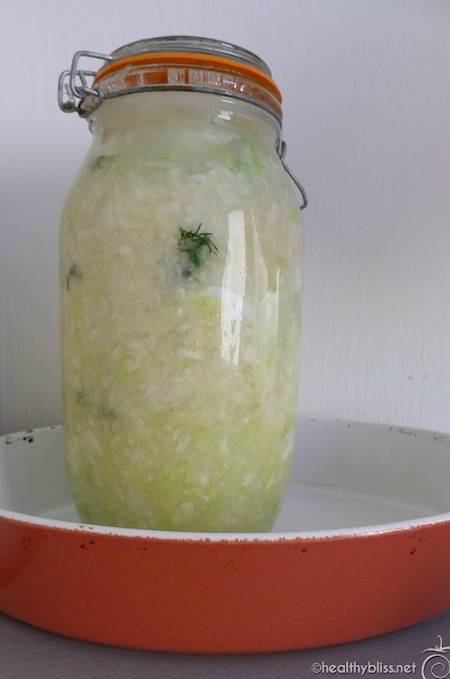
Place your sauerkraut on a dish or in a large bowl. Usually there will be liquid coming out of the jar as it ferments; this way any liquid escaping is caught and will not make a mess.
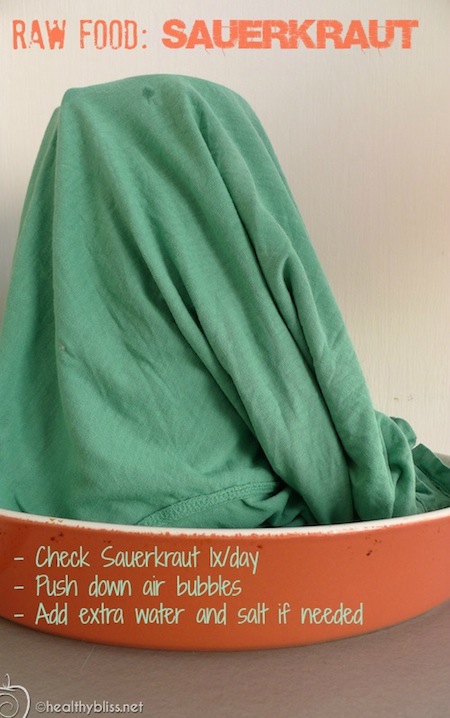
Finally, cover your sauerkraut with a towel or old t-shirt and keep it undisturbed. Check once a day, pushing out air bubbles and adding more water if needed. It should be ready in about 4 days.
Check Daily. Once a day, be sure to check your cabbage. Open the lid and push down the cabbage to release any air bubbles. If necessary, add a small amount of additional water and salt. By the 2nd day, the cabbage has usually been pressed down enough that there is some extra space in the jar. At that point, add the small baby-food jar or glass cup with rock inside to keep the cabbage submerged under water.
Taste after 4 days. Small batches of sauerkraut like this can be finished in as little as 4 days. On the 4th day, taste your cabbage. If you’re happy with the results, you can transfer your sauerkraut to the fridge where it will continue to ferment, although much more slowly. You can also keep it out to ferment for up to another 10 days, but you must check it every day, press out any air bubbles and add additional water and salt if necessary.
Note: It’s normal to see air bubbles coming through the cabbage during fermentation. When you press them down daily, you are eliminating the air space between the cabbage. In some cases if you forget a day, you may start to see mold, dark scum or smell a bad odor from the cabbage. If the scum can be skimmed off, then it’s ok to do so. If there is a bad smell or visible mold, I recommend to throw out the batch and start over.
When your sauerkraut is ready, put the large container in the fridge or transfer the sauerkraut to smaller jars and then refrigerate. Raw sauerkraut is a fermented product and will stay fresh for a few months. Once you open a jar and start eating it, it’s best to consume the sauerkraut within 30 days.

After 4 days, start tasting your batch. When you like the taste, you can transfer to smaller jars to put in fridge…or share with family and friends!
Making Large Batches of Sauerkraut
You can make much larger batches of sauerkraut in a ceramic fermentation crock, but the crocks are very expensive. It’s probably a good idea to try fermenting in glass mason jars first and see if you actually enjoy eating sauerkraut before making the investment in a crock. (One benefit of the large crock is that you don’t have to check it daily. The weights in the crock keep the air bubbles out.) Over time, if you find you want to make larger batches, then definitely consider making the leap.







How is Sauerkraut Fermented?
Raw sauerkraut is made by a process called lacto-fermentation. We can ferment cabbage thanks to the good bacteria that naturally exist on the surface of the cabbage leaves (and many other veggies too). Food becomes fermented when the “good” lactobacilli bacteria convert their sugars and starches into lactic acid. This is a natural preservative that inhibits the growth of harmful bacteria. The lactic acid also promotes the growth of healthy flora throughout the intestine. Sauerkraut contains high levels of glucosinolates. These compounds have been shown to have anti-cancer activity.
The diets of every traditional culture have included some kind of lacto-fermented food. Kimchi from Korea and cortido from Latin America are 2 examples of traditionally fermented vegetables made from lacto-fermentation. In Europe, people fermented sauerkraut, grape leaves, herbs, and root vegetables. Lacto-fermented veggies are nutrient-dense, enzyme rich, a raw food, vegan, vegetarian and gluten-free. And they taste yummy too! Fermented cabbage is one of my favorite foods for a mini-daily detox and a balanced raw food diet!
More on Fermented Foods:
- The last time I got sick was…
- Easy Recipe: Make organic pickles at home!
- How to Make Kombucha, a Naturally Fermented Health Drink
- Raw Detox Salad Recipe
- How to Ferment Cabbage and Make Raw Sauerkraut
Jennifer Betesh
Latest posts by Jennifer Betesh (see all)
- What is an elimination diet? - 28 March, 2019
- Intermittent fasting – What’s the best way? - 15 March, 2019
- How do you know when it’s time to STOP fasting - 28 February, 2019
- When is the BEST time (and WORST time) to START a detox - 20 February, 2019





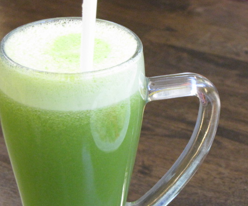





Hello Jennifer
Thank you for a very informative article. Some time ago I looked for information about how to make my own, having been surprised to read on the jars in the shops that it had been pasteurised. (I suppose it satisfies those who like it for the flavour alone). The instructions I found were very lengthy, very complicated and involved burying it in the ground. There is a much better chance I may actually try your recipe. Incidentally, your blurb talks a lot about good gut bacteria, but doesn’t mention vitamin C, which is not destroyed in the fermentation process. It is this fact that in the 18th century meant the Dutch navy had no trouble with scurvy, while other crews were severely damaged by it, and huge numbers from other nations died on the long sea voyages. When Captain Cook found out about the raw cabbage diet, and expecting resistance from the men, he tricked his rank and file sailors into eating it by insisting that all the officers do so. But he withheld it from the rest of the crew, who then demanded they get their share.
Wondering if the mason jar is sealed during fermentation or lid not really on or only a t shirt to cover lid? Does it need to breath at that time or be open to air? (As long as submerged in the brine?)
Dear Ava,
Sorry for any confusion! There is NO lid on the jar (or crock) during fermentation. Having a t-shirt or cloth covering the jar keeps the light out and helps to ferment, but it is also breathable at the same time for air to get in. And yes, the kraut definitely needs to be submerged under liquid inside the vessel! I hope that helps.
My best,
Jennifer
Hello, we have a large crock and made a batch about a week ago. the crock is only 1/4 full. can we add to the crock with fresh cabbage to fill it up?
Dear Mike,
You would have to squeeze or mash the cabbage to get the water to release from it. Adding fresh cabbage will probably not work unless you squeeze it. Also, the entire crock ingredients need to be covered with water (usually the water squeezed out of the cabbage itself is enough). If it’s not submerged with water or liquid, then you will see mold forming which is not good. If you don’t have a lot of experience fermenting, I would suggest to leave your batch as is and get a good result with what you have. Adding more now will likely change the fermentation process. You can always add more cabbage next time. Good luck!
To your health,
Jennifer
This is such a great post! I’ve tried making sauerkraut in the past, but haven’t had the best luck. I believe it was a combination of temperature and wrong salt content. I’ve heard many home fermenters saying that you should use a crock for sauerkraut; I’ve always used a mason jar. Do you have any experience with crocks? If so, do you like them better?
Dear Rhianon,
Thanks for your comment. Actually I have a crock but I haven’t used it yet! Since I started making sauerkraut using jars, I kind-of like being able to lift the towel and see in the jar to check for any mold, etc. I guess I will have to try the crock someday, when I do I’ll post my experience here! Thank you!
To your health,
Jennifer
Really great detailed content
If you rinse the Sauerkraut off before eating it do you lose the Probiotics?
Dear Earl,
What’s the point in rinsing the sauerkraut? Sorry but I’m not following your logic there. I’m fairly sure the probiotics are in the liquid and the cabbage at the point of it being sauerkraut. Hope that helps!
My best,
Jennifer
The purpose of rinsing is because some people (like me) have issues with high blood pressure. This is not because I eat all the wrong foods and are overweight. In fact, I am very thin, and eat gluten free and eat a healthy diet because of Hashimotos Thyroiditis. In spike of this, I still have salt issues. Sounds to me that I may be loosing the benefits of eating this in my lunch sandwich most every day. Maybe a chemist would be the correct person to ask.
Dear Pauline,
There are other fermented foods you can eat that do not contain any salt, such as kefir or kombucha. Those may be better options for you if looking for a no salt diet. In my experience, supplementing the diet with zinc and selenium helps greatly with your condition, as there is often zinc and selenium deficiency present. With added high blood pressure, you may also be low in magnesium.
My best,
To your health,
Jennifer
Great guide
Thank you, I really enjoyed reading this and I’m looking forward to making some, but I do have one question, should we wash the cabbage, of would washing it remove the bacteria needed for the fermentation?
Thank you
Hi Bonnie,
I discard the outer leaves and wash the whole outside of the cabbage but that’s pretty much it since the inside is so tightly wrapped. The natural bacteria is in the leaves as far as I know and rinsing with water will not remove that. I’ve never had a problem so far!
Good luck and happy fermenting!
To your health,
Jennifer
Can I heat up saurkraut and other fermented foods for meals without killing the good bacteria?
Hi Becky,
Nearly all bacteria is destroyed in the process of heating to a high temperature (i.e. cooking). You could most likely heat the sauerkraut up to but not more than 118F and still maintain most of the good bacteria….but my question would be why bother? Eating raw sauerkraut in its raw and fermented state gives you all of the healing power of the good bacteria and enzymes, as nature intended!
My best,
To your health,
Jennifer
As nature intended? Was sauerkraut part of the early homo sapiens hunter/gatherer diet?
Where on earth did they find the proper jars a half million years ago? Must have been difficult. That, and getting eaten by sabre-toothed tigers. That will ruin anyone’s day.
Dear Richard,
It’s certainly possible that people were fermenting foods long before we knew it. If you’ve ever worked with fermentation before, you would know that it doesn’t take any fancy equipment at all! In fact, you could bury veggies in the ground to create a fermentation vessel. Definitely don’t need fire to do it!
I’m not sure why you’re so caught up on half a million years ago, but look at yourself in the present time mate. Are you helping yourself or others to be wasting time tapping senseless comments in cyber world? Personally, I’ve got way better things to do!! Like make some amazing raw sauerkraut with the fresh veggies from my organic garden, yum!
Good luck with the tigers, I know they’re still out there for sure!!!
Thank you SO much for this guidance! I am fascinated by fermented nutrition and just beginning to learn how!
thank you very much for your Good content
If I make sauerkraut and then freeze some of it will that kill the good bacteria?